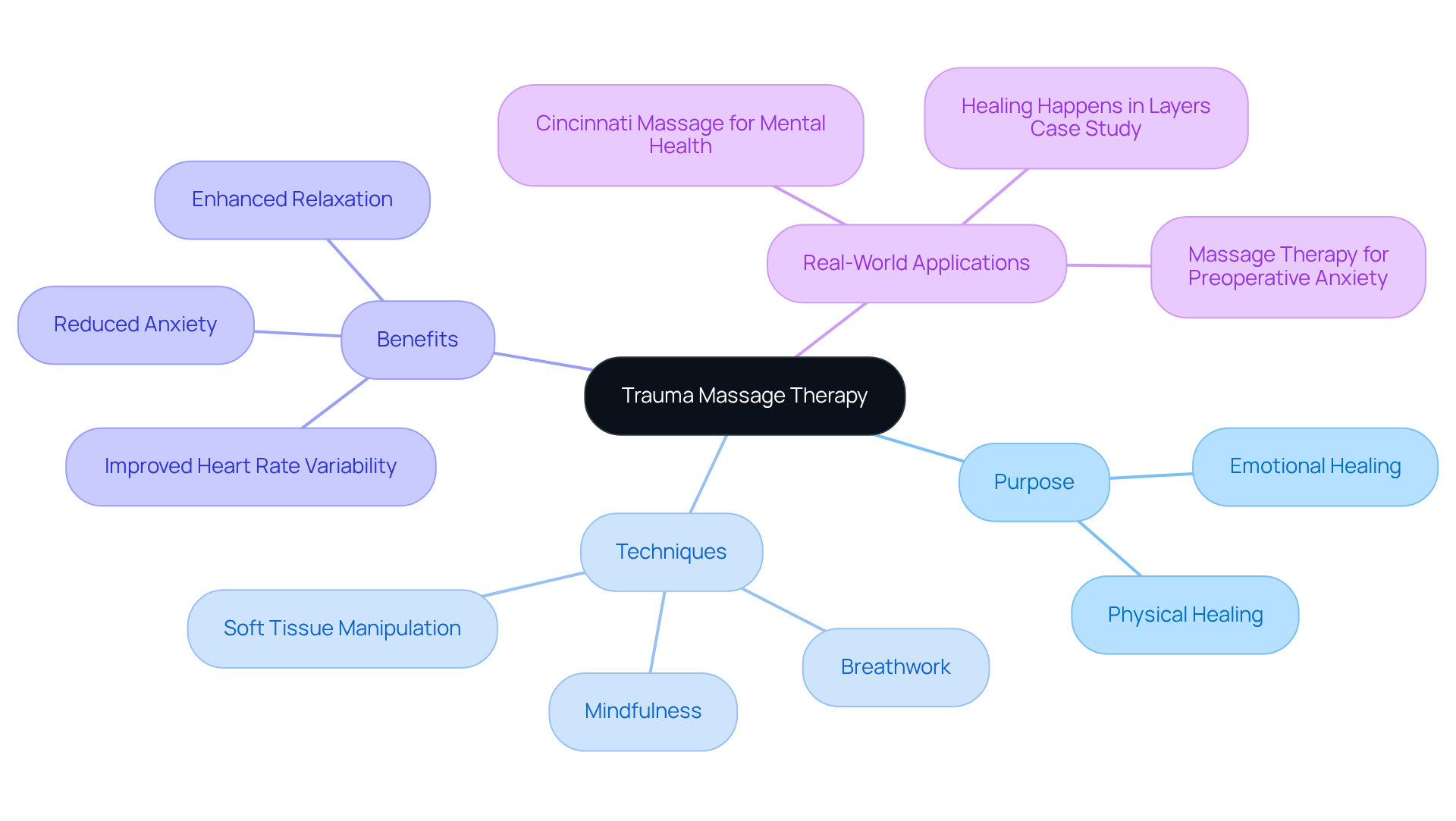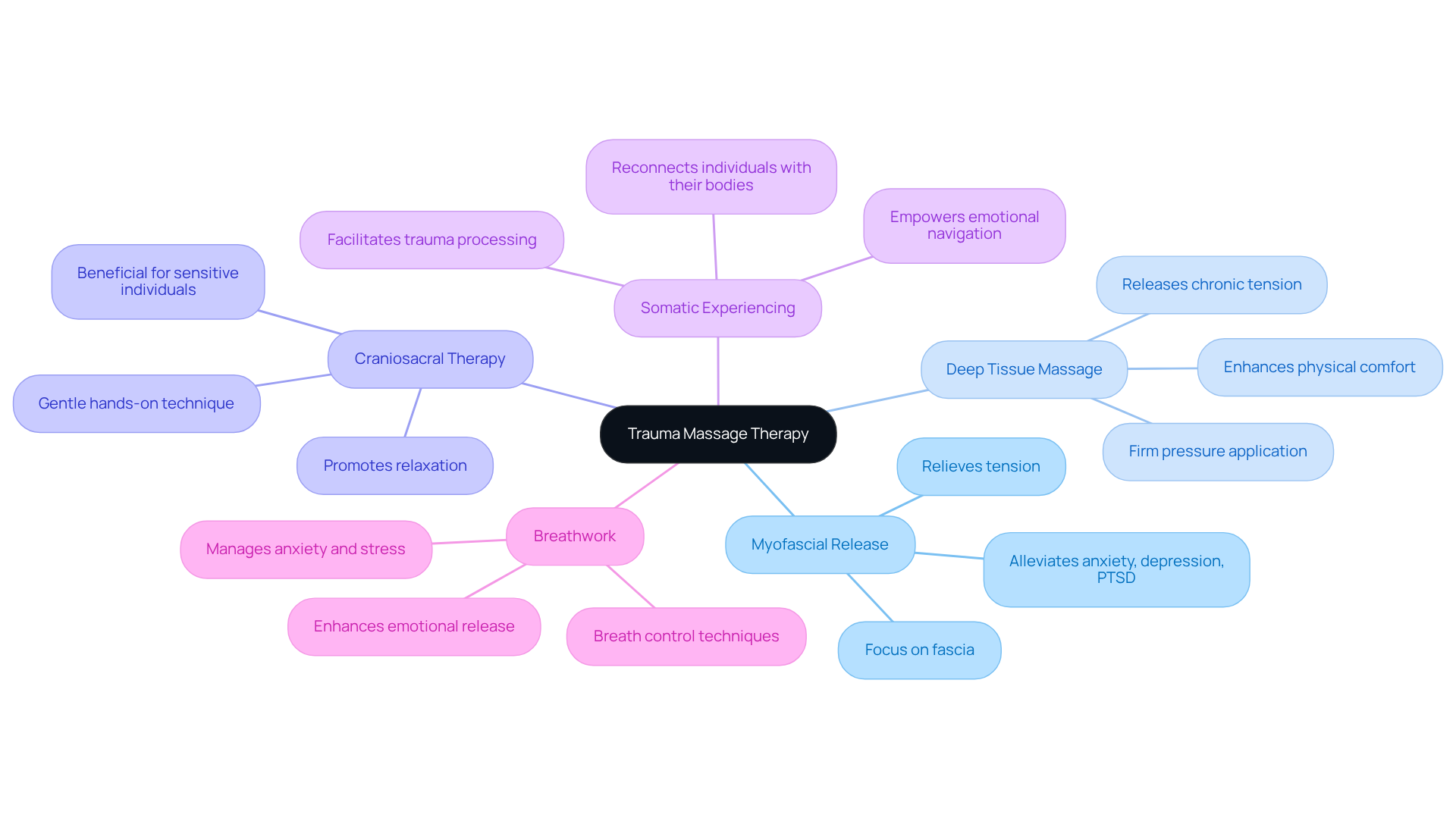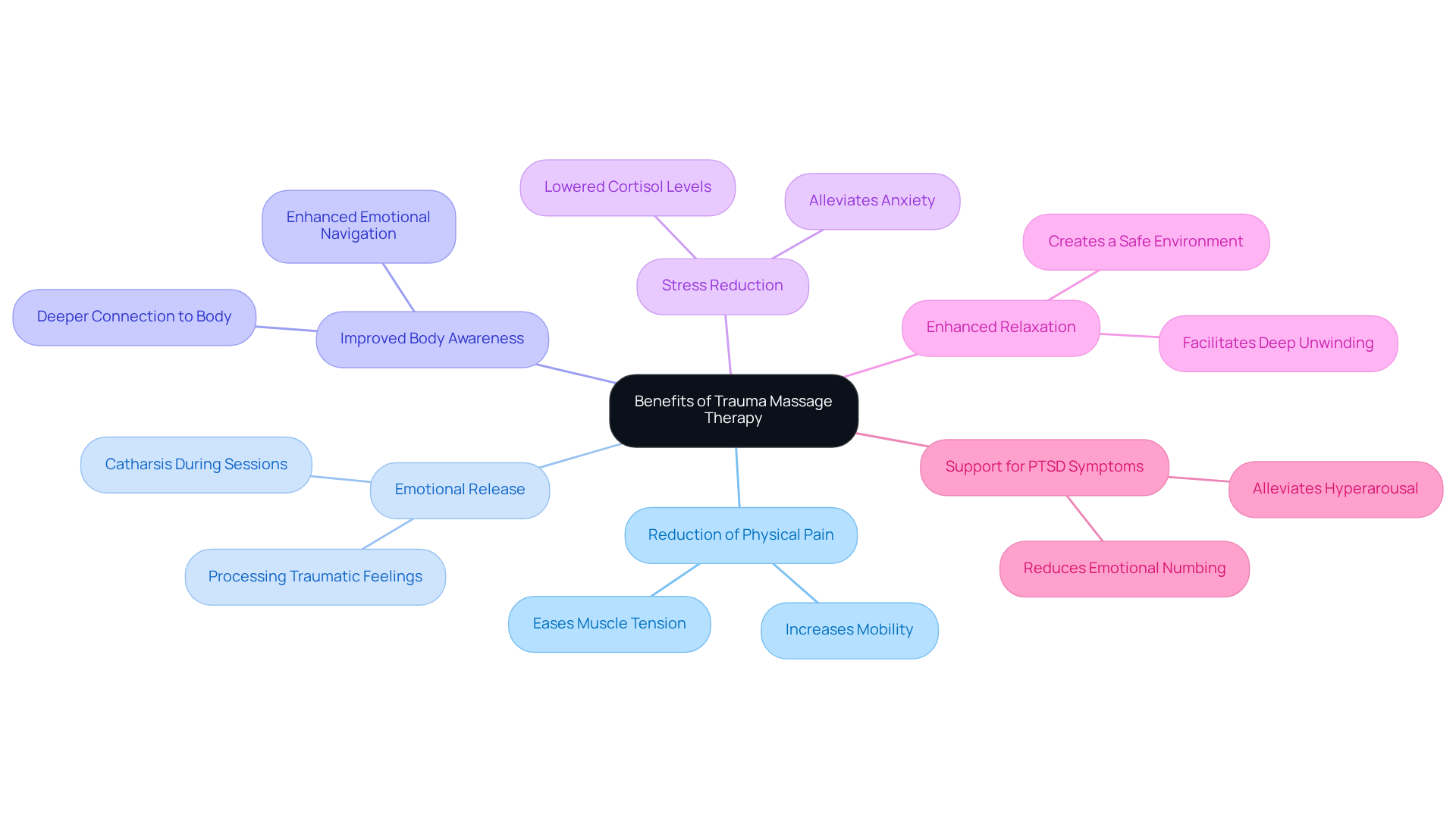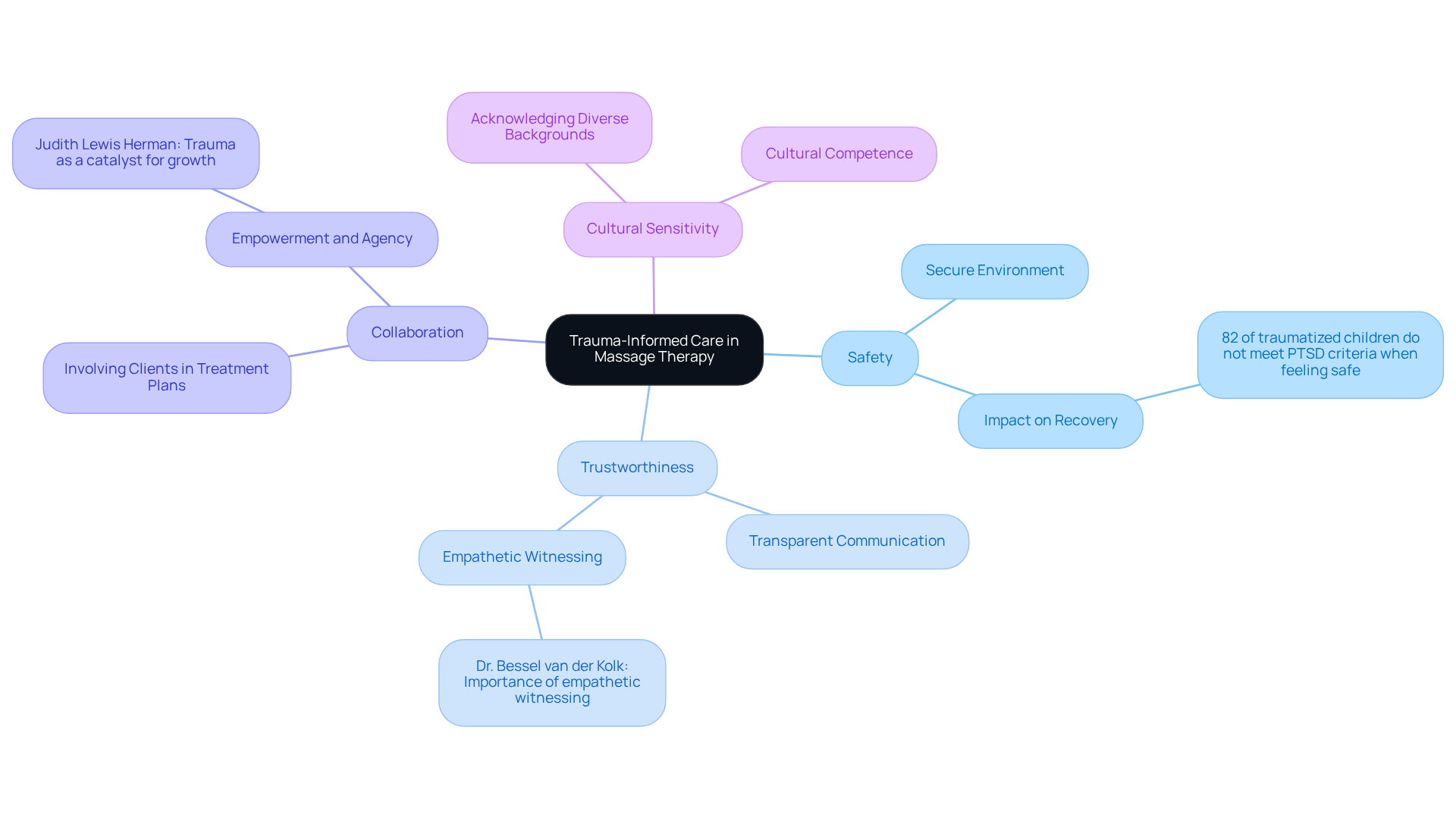Overview
Trauma massage therapy is a compassionate treatment crafted to assist individuals in healing from both physical and emotional distress. By employing various techniques that promote relaxation, emotional release, and enhanced body awareness, this therapy nurtures the healing journey.
Have you ever felt overwhelmed by your past? This therapeutic approach not only alleviates physical pain but also supports emotional healing, making it an essential component of recovery for those affected by trauma.
When integrated with trauma-informed care principles, it fosters a deeper sense of well-being and connection. As we explore this further, consider how trauma massage therapy could be a vital step in your healing process.
Introduction
Trauma massage therapy offers a deeply nurturing approach to healing, intertwining physical relief with emotional rejuvenation. Through specialized techniques designed to address both the body and mind, this therapy provides individuals a pathway to release tension and navigate the complexities of their past experiences.
Have you ever felt overwhelmed by your past? As the healing journey unfolds, how can one truly harness the full potential of trauma massage therapy to foster resilience and empowerment?
Exploring the nuances of this therapeutic practice reveals not only its profound benefits but also the critical importance of trauma-informed care in enhancing the overall recovery experience. In addition to this, it invites us to consider how we can embrace our healing journey with compassion and support.
Define Trauma Massage Therapy and Its Purpose
Injury relief bodywork, such as trauma massage therapy, is a specialized type of treatment designed to assist individuals in healing from both physical and emotional distress. This therapeutic approach, known as trauma massage therapy, employs a range of techniques tailored to address the specific needs of those recovering from distressing experiences, emphasizing the creation of a secure and nurturing environment. The primary goal of injury treatment is to help individuals release built-up tension, reduce discomfort, and promote emotional healing by enhancing the connection between the mind and body.
Have you ever felt overwhelmed by your past? Research indicates that experiences of fear or helplessness can leave lasting imprints on the body, often resulting in muscle tension and emotional overwhelm. By addressing these physical manifestations, therapists can facilitate recovery and resilience in their clients.
The advantages of therapeutic bodywork extend beyond simple relaxation. Research has shown that even brief sessions, such as a 10-minute treatment, can significantly improve heart rate variability, suggesting enhanced activation of the parasympathetic nervous system, which is vital for relaxation. In addition to this, soft tissue manipulation has been linked to decreases in anxiety levels. A study revealed that participants undergoing gentle bodywork reported notably lower perceived anxiety compared to those utilizing conventional relaxation methods.
Real-world applications of trauma massage therapy illustrate its effectiveness. For example, a case study named 'Healing Happens in Layers' emphasizes the non-linear aspect of healing, demonstrating how incorporating mindfulness, breathwork, and bodywork can lead to significant emotional rejuvenation. Furthermore, practices like Cincinnati Massage for Mental Health showcase a trauma massage therapy approach, where therapists are trained to create a sanctuary that addresses both emotional and physical well-being.
Experts in the field highlight the importance of healing touch practices in restoring tranquility rather than merely dismissing previous wounds. This comprehensive method not only aids in emotional processing but also helps individuals navigate their unique challenges, ultimately fostering a sense of safety and empowerment in their healing journey. As we explore this further, consider how such supportive practices could enhance your own path to healing.

Explore Techniques Used in Trauma Massage Therapy
Techniques commonly utilized in trauma massage therapy include:
- Myofascial Release: This method focuses on the fascia, the connective tissue that envelops muscles and can hold onto trauma. By relieving tension in this area, clients often find significant relief and improved mobility. Research suggests that trauma massage therapy can notably alleviate symptoms of anxiety, depression, and PTSD.
- Deep Tissue Massage: This approach applies firm pressure to deeper muscle layers and connective tissues, effectively releasing chronic tension and pain. Case studies reveal that survivors of distress frequently report enhanced physical comfort and emotional well-being following these sessions.
- Craniosacral Therapy: A gentle, hands-on technique that assesses and enhances the function of the craniosacral system, promoting relaxation and healing. This approach is particularly beneficial for individuals who may be sensitive to more intense forms of bodywork.
- Somatic Experiencing: This technique encourages individuals to reconnect with their bodies, facilitating the processing of trauma through awareness and movement. It empowers individuals to navigate their emotional landscapes safely.
- Breathwork: Incorporating breath control techniques assists individuals in managing anxiety and stress, fostering emotional release during sessions. This practice not only enhances relaxation but also supports the overall therapeutic process.
Each of these techniques is applied through trauma massage therapy, prioritizing the individual's comfort and safety throughout the experience. Have you ever felt overwhelmed by your past? As David Malmborg emphasizes, being trauma-informed means creating safety, listening with compassion, and respecting boundaries. This comprehensive method not only addresses physical symptoms but also nurtures emotional healing, making recovery-focused bodywork an essential element of restoration. Furthermore, it is significant that around 75% of bodywork recipients are women, many of whom seek treatment for stress and trauma-related concerns.

Discuss the Benefits of Trauma Massage Therapy for Healing
Trauma-focused bodywork offers a wide array of benefits that can significantly enhance the recovery journey for those grappling with distress, particularly when paired with Cognitive Processing Treatment (CPT). Let's explore some of these key advantages together:
- Reduction of Physical Pain: Imagine feeling the immediate relief that trauma massage therapy can provide. By easing muscle tension and discomfort, clients often notice a decrease in chronic pain and an increase in mobility. This physical relief beautifully complements the emotional processing that takes place during CPT.
- Emotional Release: Have you ever felt a wave of emotions wash over you unexpectedly? Many clients share their experiences of profound emotional catharsis during sessions, which helps them process feelings tied to their traumatic experiences. This emotional release can be a pivotal moment in their healing journey, especially when combined with the structured approach of CPT.
- Improved Body Awareness: As clients engage in bodywork, they frequently develop a deeper connection to their bodies, fostering a sense of empowerment and grounding. This newfound awareness can assist them in navigating their emotional landscapes more effectively, enhancing the therapeutic results of both bodywork and CPT.
- Stress Reduction: The soothing effects of bodywork contribute to lower cortisol levels, which in turn alleviates overall stress and anxiety. This physiological response is vital for trauma survivors, who often endure heightened stress responses. Trauma massage therapy serves as a valuable addition to their treatment plan.
- Enhanced Relaxation: Trauma therapy creates a sanctuary of safety and security within the body, allowing individuals to unwind deeply and feel more at ease during and after sessions. Establishing a comfortable atmosphere is crucial for those with PTSD, as it nurtures a sense of security during their healing process.
- Support for PTSD Symptoms: Research shows that bodywork can help alleviate various PTSD symptoms, including hyperarousal and emotional numbing. This support enhances the overall therapeutic experience, especially as individuals engage in CPT, assisting them in managing symptoms more effectively.
In summary, bodywork for distress serves as a valuable complement to conventional therapeutic methods, enriching the recovery process and supporting individuals on their journey toward healing. By integrating injury relief techniques with Cognitive Processing Therapy, individuals can experience a more holistic approach to their recovery, addressing both the physical and emotional dimensions of their distress.

Highlight the Importance of Trauma-Informed Care in Massage Therapy
Trauma massage therapy is built on the principles of trauma-informed care, which guides practitioners to interact with each individual with sensitivity and a deep awareness of their unique experiences. The essential components of trauma-informed care include:
-
Safety: Establishing a secure environment where clients feel respected and protected is paramount. Have you ever felt truly safe in a space? Studies reveal that individuals who perceive their treatment environment as secure are more inclined to engage fully in their recovery journey. For instance, research indicates that 82% of traumatized children do not meet diagnostic criteria for PTSD when they feel safe in therapeutic settings. At The Emerald Couch, our therapists prioritize creating a nurturing space, recognizing that this is foundational for effective healing.
-
Trustworthiness: Building trust through transparent communication and consistent practices is vital. Clients often express feeling more at ease when therapists clearly outline what to expect during sessions, fostering a sense of comfort and security. Dr. Bessel van der Kolk highlights the importance of empathetic witnessing in trauma recovery, reinforcing the necessity of trust within the therapeutic relationship. Therapists like Rachel Kirkman and Mitra Lebastchi exemplify this trust-building approach, ensuring individuals feel supported and understood through evidence-based therapies such as Acceptance and Commitment Therapy (ACT) and Cognitive Behavioral Therapy (CBT).
-
Collaboration: Actively involving individuals in their treatment plans enhances their sense of agency and empowerment. This collaborative approach not only respects their autonomy but also nurtures a deeper commitment to the healing journey. Judith Lewis Herman notes that trauma can serve as a catalyst for personal growth, emphasizing the transformative potential of a supportive therapeutic environment. At The Emerald Couch, we believe in empowering those we serve to take an active role in their healing process.
-
Cultural Sensitivity: Acknowledging and honoring the diverse backgrounds and experiences of individuals is crucial for effective care. Therapists who exhibit cultural competence can better engage with individuals, resulting in enhanced therapeutic outcomes. Our team is dedicated to understanding and respecting the unique cultural contexts of each individual, which strengthens the therapeutic alliance.
Incorporating these principles into practice enables therapists to establish a supportive and healing environment for individuals navigating the challenges of trauma recovery. As Carrie Riley, a leader in trauma massage therapy, emphasizes, 'Our practice bridges a critical gap in healthcare by addressing how emotional experiences manifest physically in the body.' By prioritizing these elements, therapists at The Emerald Couch can significantly enhance the therapeutic experience, ultimately supporting individuals in their journey toward healing and resilience. Furthermore, real-world examples, such as the impact of CMMH's trauma-informed approach on clients, illustrate the practical application of these principles.

Conclusion
Trauma massage therapy serves as a vital approach for individuals navigating both physical and emotional distress. By utilizing a variety of techniques tailored to personal needs, this therapeutic practice not only alleviates tension but also nurtures a deeper connection between mind and body. Ultimately, it promotes a sense of safety and empowerment on the healing journey.
As we explore this further, the multifaceted benefits of trauma massage therapy become evident. These include:
- Reduction of physical pain
- Emotional release
- Improved body awareness
- Significant stress reduction
Techniques such as myofascial release, deep tissue massage, craniosacral therapy, and breathwork are essential tools in this healing process. They emphasize the importance of a trauma-informed care approach, which prioritizes safety, trust, collaboration, and cultural sensitivity.
In recognizing the profound impact of trauma massage therapy, consider how these practices can enhance your personal recovery journey. Have you ever felt overwhelmed by your past? By seeking out trauma-informed care, individuals can experience a holistic approach to healing that addresses not only physical symptoms but also nurtures emotional well-being. Embracing these therapeutic techniques may offer a pathway to resilience, inviting you to take active steps toward your own healing and recovery.
Frequently Asked Questions
What is trauma massage therapy?
Trauma massage therapy is a specialized type of bodywork designed to assist individuals in healing from both physical and emotional distress. It employs various techniques tailored to the specific needs of those recovering from distressing experiences, focusing on creating a secure and nurturing environment.
What is the primary goal of trauma massage therapy?
The primary goal of trauma massage therapy is to help individuals release built-up tension, reduce discomfort, and promote emotional healing by enhancing the connection between the mind and body.
How does trauma impact the body?
Experiences of fear or helplessness can leave lasting imprints on the body, often resulting in muscle tension and emotional overwhelm. Trauma massage therapy addresses these physical manifestations to facilitate recovery and resilience.
What are the benefits of therapeutic bodywork?
Therapeutic bodywork offers benefits beyond simple relaxation. Research indicates that even brief sessions can improve heart rate variability, enhance activation of the parasympathetic nervous system, and decrease anxiety levels.
Can you provide an example of trauma massage therapy in practice?
One example is the case study 'Healing Happens in Layers,' which emphasizes the non-linear aspect of healing. It demonstrates how incorporating mindfulness, breathwork, and bodywork can lead to significant emotional rejuvenation.
What is the role of therapists in trauma massage therapy?
Therapists are trained to create a sanctuary that addresses both emotional and physical well-being, utilizing healing touch practices to restore tranquility and aid in emotional processing.
How does trauma massage therapy foster empowerment in healing?
By helping individuals navigate their unique challenges and fostering a sense of safety, trauma massage therapy supports clients in their healing journey and empowers them to process their experiences effectively.




